OBD标定流程
- 格式:pdf
- 大小:206.79 KB
- 文档页数:15
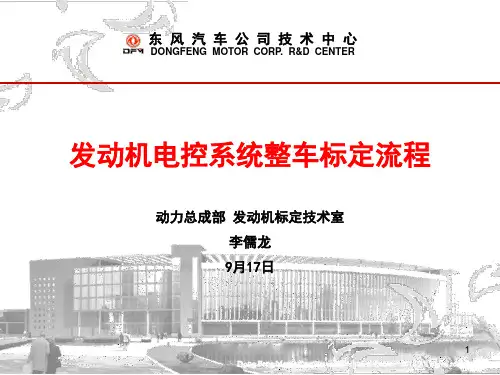
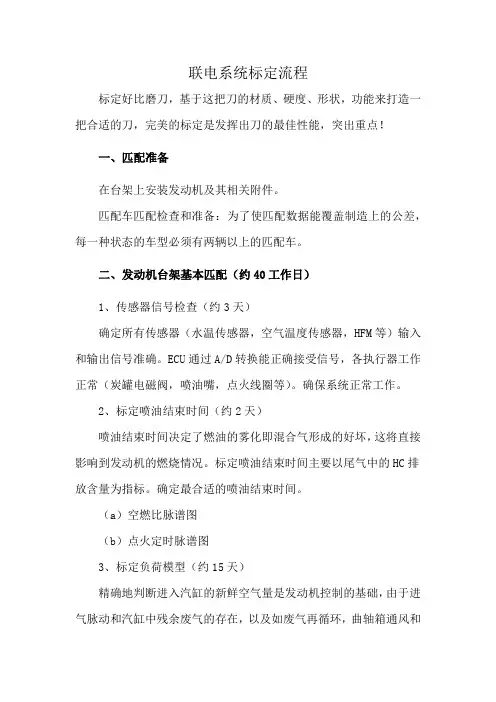
联电系统标定流程标定好比磨刀,基于这把刀的材质、硬度、形状,功能来打造一把合适的刀,完美的标定是发挥出刀的最佳性能,突出重点!一、匹配准备在台架上安装发动机及其相关附件。
匹配车匹配检查和准备:为了使匹配数据能覆盖制造上的公差,每一种状态的车型必须有两辆以上的匹配车。
二、发动机台架基本匹配(约40工作日)1、传感器信号检查(约3天)确定所有传感器(水温传感器,空气温度传感器,HFM等)输入和输出信号准确。
ECU通过A/D转换能正确接受信号,各执行器工作正常(炭罐电磁阀,喷油嘴,点火线圈等)。
确保系统正常工作。
2、标定喷油结束时间(约2天)喷油结束时间决定了燃油的雾化即混合气形成的好坏,这将直接影响到发动机的燃烧情况。
标定喷油结束时间主要以尾气中的HC排放含量为指标。
确定最合适的喷油结束时间。
(a)空燃比脉谱图(b)点火定时脉谱图3、标定负荷模型(约15天)精确地判断进入汽缸的新鲜空气量是发动机控制的基础,由于进气脉动和汽缸中残余废气的存在,以及如废气再循环,曲轴箱通风和油箱通风等导致的进气量变化,使得完全依靠传感器来精确判断进气量已不可能。
负荷模型通过测量进气压力,燃油消耗量,原始排放和空燃比,以及各种环境和发动机参数,并通过一系列的数学模型和函数对各种工况下的进气特性进行计算和模拟,最终达到精确地判断进入汽缸的新鲜空气量的目的。
标定负荷模型所需的工作量随系统配置的复杂程度变化,如可变进气系统(进气长短管切换),可变气门正时系统,废气再循环系统废气涡轮增压系统等都会大大地增加负荷模型的匹配时间。
4、标定喷油量(约2天)在负荷模型匹配好以后,按照理论计算可以得到在各工况点让空燃比λ=1的喷油量,但是由于供油系统也存在偏差,导致在某些情况下空燃比偏离1,这需要在这里得到修正。
5、扭矩模型(约15天)发动机的扭矩是发动机控制系统的中心变量,因此首先要匹配发动机在各种转速和节气门开度下,在空燃比等于1以及各种点火提前角等条件下,发动机所能发出的最大扭矩,这是发动机扭矩控制的基础值(对应100%的空燃比效率和100%的点火角效率)。
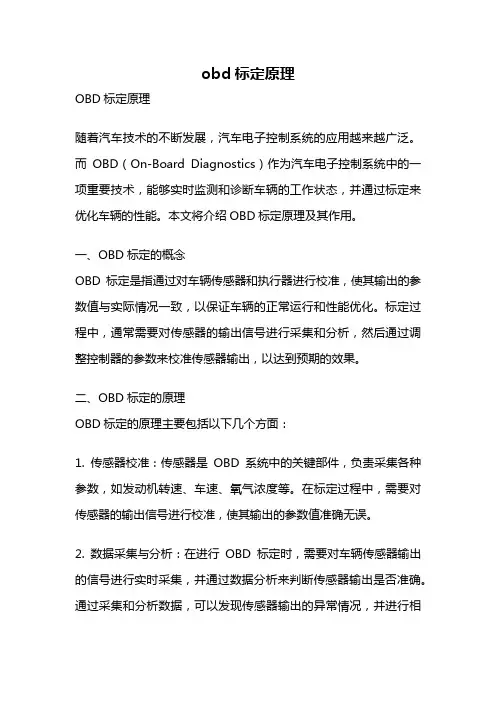
obd标定原理OBD标定原理随着汽车技术的不断发展,汽车电子控制系统的应用越来越广泛。
而OBD(On-Board Diagnostics)作为汽车电子控制系统中的一项重要技术,能够实时监测和诊断车辆的工作状态,并通过标定来优化车辆的性能。
本文将介绍OBD标定原理及其作用。
一、OBD标定的概念OBD标定是指通过对车辆传感器和执行器进行校准,使其输出的参数值与实际情况一致,以保证车辆的正常运行和性能优化。
标定过程中,通常需要对传感器的输出信号进行采集和分析,然后通过调整控制器的参数来校准传感器输出,以达到预期的效果。
二、OBD标定的原理OBD标定的原理主要包括以下几个方面:1. 传感器校准:传感器是OBD系统中的关键部件,负责采集各种参数,如发动机转速、车速、氧气浓度等。
在标定过程中,需要对传感器的输出信号进行校准,使其输出的参数值准确无误。
2. 数据采集与分析:在进行OBD标定时,需要对车辆传感器输出的信号进行实时采集,并通过数据分析来判断传感器输出是否准确。
通过采集和分析数据,可以发现传感器输出的异常情况,并进行相应的调整。
3. 参数调整:通过对控制器的参数进行调整,可以改变传感器的输出值。
调整控制器参数的目的是使传感器输出的参数值与实际情况相符,从而保证车辆的正常运行和性能优化。
4. 标定结果验证:在完成标定后,需要对标定结果进行验证,以确保标定效果的准确性和稳定性。
验证的方法通常是进行实际测试,比较测试结果与预期结果的差异,从而判断标定是否成功。
三、OBD标定的作用OBD标定在车辆电子控制系统中起着至关重要的作用,主要体现在以下几个方面:1. 节能减排:通过OBD标定可以优化发动机燃烧过程,减少能量损失,从而提高燃油利用率,减少尾气排放,达到节能减排的目的。
2. 提升驾驶体验:通过对传感器的标定,可以提高车辆性能,如提高加速性能、提升悬挂系统的稳定性等,从而提升驾驶体验。
3. 故障诊断:OBD系统可以实时监测和诊断车辆的工作状态。
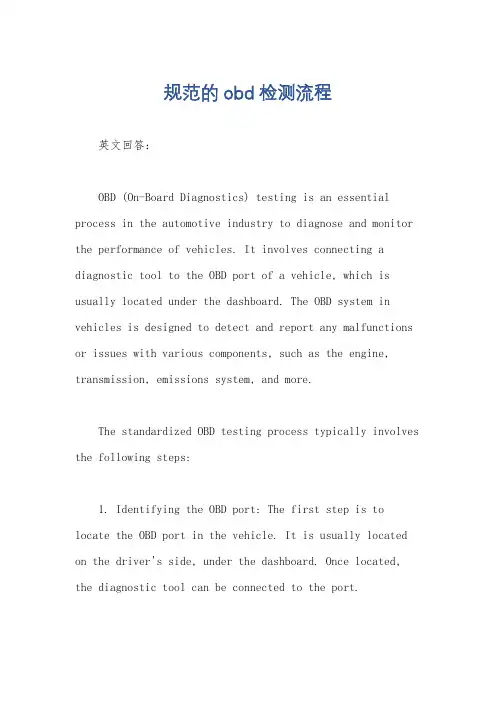
规范的obd检测流程英文回答:OBD (On-Board Diagnostics) testing is an essential process in the automotive industry to diagnose and monitor the performance of vehicles. It involves connecting a diagnostic tool to the OBD port of a vehicle, which is usually located under the dashboard. The OBD system in vehicles is designed to detect and report any malfunctions or issues with various components, such as the engine, transmission, emissions system, and more.The standardized OBD testing process typically involves the following steps:1. Identifying the OBD port: The first step is to locate the OBD port in the vehicle. It is usually located on the driver's side, under the dashboard. Once located, the diagnostic tool can be connected to the port.2. Connecting the diagnostic tool: The diagnostic tool, which can be a handheld device or a computer-based system,is connected to the OBD port using a cable or a wireless connection. The tool communicates with the vehicle's OBD system to retrieve diagnostic information.3. Retrieving diagnostic codes: Once connected, the diagnostic tool retrieves any diagnostic trouble codes (DTCs) stored in the vehicle's OBD system. These codes indicate specific issues or malfunctions in the vehicle's systems. The tool displays the codes, which can be alphanumeric, along with a brief description of the problem.4. Interpreting the codes: The technician or user then interprets the diagnostic codes to identify the underlying problem. This requires knowledge and experience to understand the meaning of each code and its relevance tothe vehicle's systems. For example, a P0301 code indicatesa misfire in cylinder 1, while a P0420 code indicates a catalytic converter efficiency below threshold.5. Performing further diagnostics: Based on theretrieved codes and their interpretation, further diagnostics may be required to pinpoint the exact cause of the problem. This can involve conducting tests, inspecting components, or using additional diagnostic tools.6. Repairing the issue: Once the problem is identified, the necessary repairs or maintenance procedures can be performed. This can range from simple fixes like replacing a faulty sensor to more complex repairs involving engine or transmission components.7. Clearing the codes: After the repairs are completed, the diagnostic tool is used to clear the diagnostic trouble codes from the vehicle's OBD system. This ensures that the system recognizes that the issue has been resolved and allows the vehicle to pass the OBD test.8. Re-testing and verification: In some cases, it may be necessary to re-test the vehicle to ensure that the repairs were successful and that no new issues have arisen. This step helps to ensure that the vehicle is in compliance with the OBD standards and is functioning properly.中文回答:OBD(车载诊断)检测是汽车行业中的一个重要过程,用于诊断和监控车辆的性能。

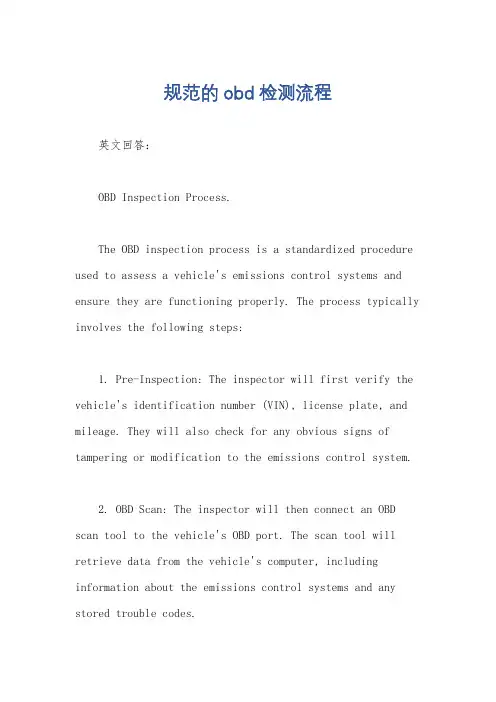
规范的obd检测流程英文回答:OBD Inspection Process.The OBD inspection process is a standardized procedure used to assess a vehicle's emissions control systems and ensure they are functioning properly. The process typically involves the following steps:1. Pre-Inspection: The inspector will first verify the vehicle's identification number (VIN), license plate, and mileage. They will also check for any obvious signs of tampering or modification to the emissions control system.2. OBD Scan: The inspector will then connect an OBD scan tool to the vehicle's OBD port. The scan tool will retrieve data from the vehicle's computer, including information about the emissions control systems and any stored trouble codes.3. Visual Inspection: The inspector will perform a visual inspection of the vehicle's emissions control system to look for any signs of damage or wear. This may include checking the condition of the catalytic converter, exhaust system, and oxygen sensors.4. Functional Test: The inspector may perform a functional test of the vehicle's emissions control system to assess its operation. This may involve driving the vehicle under various conditions, such as idling, acceleration, and deceleration.5. Data Analysis: The inspector will analyze the data collected from the OBD scan and visual inspection to determine if the vehicle meets emissions standards. If any trouble codes are present, the inspector will investigate the cause and recommend repairs.6. Report Generation: The inspector will generate a report summarizing the results of the inspection. The report will include information about the vehicle'semissions performance, any trouble codes, and recommended repairs.中文回答:OBD检测流程。
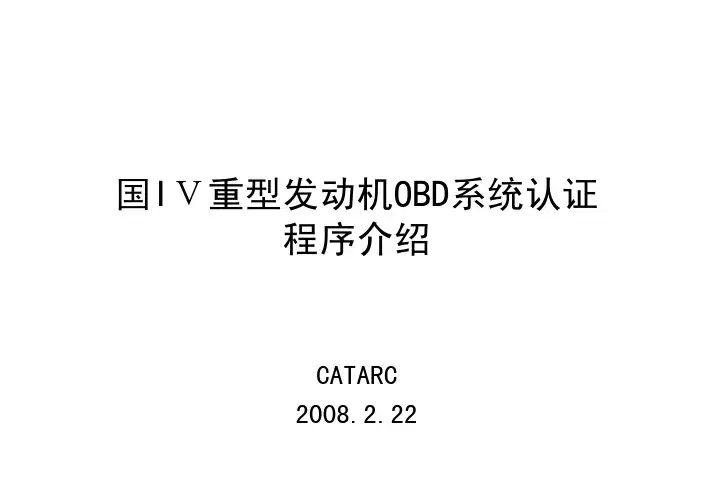
国IV重型发动机OBD系统认证程序介绍CATARC2008.2.221.依据欧盟指令2005/55/EC和2005/78/EC和2006/51/EC中的有关技术内容。
•2.试验前的准备---OBD系统资料的提供-故障指示器MI的书面描述和示意图;-OBD系统监督的所有部件的清单和目的, OBD所用的所有输出代-码和格式的清单(每一个都要加以说明);-该机型OBD系统型式认证时,预处理循环的类型和次数;-型式认证时,对OBD系统监测的部件OBD验证循环的类型和次数;-对所有传感部件及其故障监测和MI激活策略(运转循环的固定次数或统计方法);-OBD基本工作原理的书面说明(催化器监控\降NOX 系统的监控\颗粒物捕集器监控\电子燃油系统监控\OBD系统监控的其他部件) ;-提供后处理系统严重功能性故障监测的基础参数(如适用);-扭矩限制器激活的描述,全负荷曲线限制的描述;-提供监测任何NOx控制措施异常工况而导致扭矩限制器激活或只是报警信号激活的排放控制监测系统故障的监测策略;-排放控制系统中,ECU使用的在ETC测试循环中NOx浓度与NOx排放(g/kWh)明确的对应关系的计算方法。
3.认证试验项目对于OBD 1阶段对不同系统或部件试验所发生的故障总数可以不超过4项。
如果型式认证试验时,是按照OBD-发动机族系来进行认证,申请认证的发动机不属于同一发动机族系,型式认证机关对试验中发生的故障次数,最多将增加到OBD-发动机系族中发动机系族数的四倍。
在达到故障试验的最大试验次数前,型式认证机关可以随时作出决定减少试验。
试验项目可以选择如下项目:---如果发动机装有独立催化器,无论其安装的壳体属于还是不属于降氮氧化物(deNO x )系统或柴油机颗粒捕集器的一部分,将其替换为已劣化或有缺陷的催化器,或用电子仪器模拟已劣化或有缺陷的催化器,测试故障指示灯(MI) 是否激活, 不需测试排放。
3.认证试验项目对于OBD 1阶段---如果发动机装有降氮氧化物(deNO x )系统(包括构成系统所需的传感器),将其替换为已劣化或有缺陷的降氮氧化物(deNO x )系统,或用电子仪器模拟已劣化或有缺陷的降氮氧化物(deNO x )系统,使其排放量超过本规范中规定的OBD 限值中NOx 的限值但是,如果发动机OBD系统仅监测降氮氧化物(deNOx)系统严重功能性故障,在降氮氧化物(deNOx)系统的试验中,应测试故障指示灯(MI) 在下列任何条件下是否激活, 不需测试排放:--完全拆除系统或用假系统替换原系统;--缺少降氮氧化物(deNO x )系统任何所需的反应试剂;--降氮氧化物(NO x )系统中部件(如传感器、执行器、定量控制装置)的任何电故障,包括反应剂加热系统的任何电故障(如适用);--降氮氧化物(deNO x )系统的反应剂定量系统故障(如缺少空气供应、喷咀堵塞、定量泵故障);--系统严重损坏;对于OBD 1阶段----如果发动机装有颗粒捕集器,整体拆除颗粒捕集器,或将其替换为已劣化或有缺陷的颗粒捕集器,使其排放量超过本规范中OBD限值中值颗粒物限值。
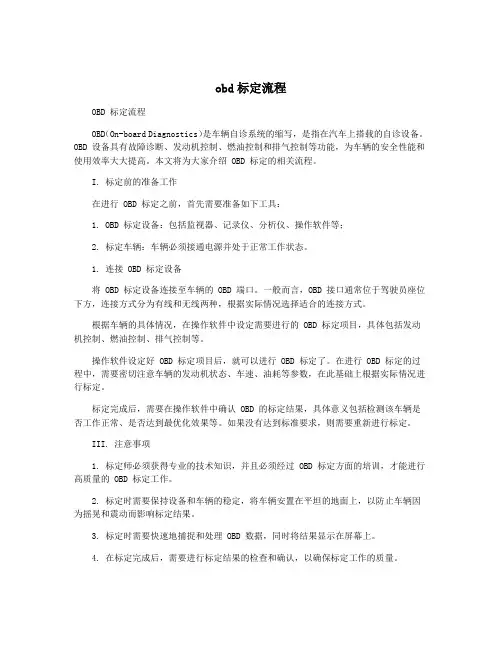
obd标定流程OBD 标定流程OBD(On-board Diagnostics)是车辆自诊系统的缩写,是指在汽车上搭载的自诊设备。
OBD 设备具有故障诊断、发动机控制、燃油控制和排气控制等功能,为车辆的安全性能和使用效率大大提高。
本文将为大家介绍 OBD 标定的相关流程。
I. 标定前的准备工作在进行 OBD 标定之前,首先需要准备如下工具:1. OBD 标定设备:包括监视器、记录仪、分析仪、操作软件等;2. 标定车辆:车辆必须接通电源并处于正常工作状态。
1. 连接 OBD 标定设备将 OBD 标定设备连接至车辆的 OBD 端口。
一般而言,OBD 接口通常位于驾驶员座位下方,连接方式分为有线和无线两种,根据实际情况选择适合的连接方式。
根据车辆的具体情况,在操作软件中设定需要进行的 OBD 标定项目,具体包括发动机控制、燃油控制、排气控制等。
操作软件设定好 OBD 标定项目后,就可以进行 OBD 标定了。
在进行 OBD 标定的过程中,需要密切注意车辆的发动机状态、车速、油耗等参数,在此基础上根据实际情况进行标定。
标定完成后,需要在操作软件中确认 OBD 的标定结果,具体意义包括检测该车辆是否工作正常、是否达到最优化效果等。
如果没有达到标准要求,则需要重新进行标定。
III. 注意事项1. 标定师必须获得专业的技术知识,并且必须经过 OBD 标定方面的培训,才能进行高质量的 OBD 标定工作。
2. 标定时需要保持设备和车辆的稳定,将车辆安置在平坦的地面上,以防止车辆因为摇晃和震动而影响标定结果。
3. 标定时需要快速地捕捉和处理 OBD 数据,同时将结果显示在屏幕上。
4. 在标定完成后,需要进行标定结果的检查和确认,以确保标定工作的质量。
5. 一些特殊情况需要进行修正:如电瓶未充满电、设备故障等,标定师都需要有修正的能力。
本文介绍了 OBD 标定流程及其注意事项,希望对广大读者有所帮助。
OBD 标定在车辆维护和修理中具有重要意义,可以大大提高车辆的使用效率和安全性能。
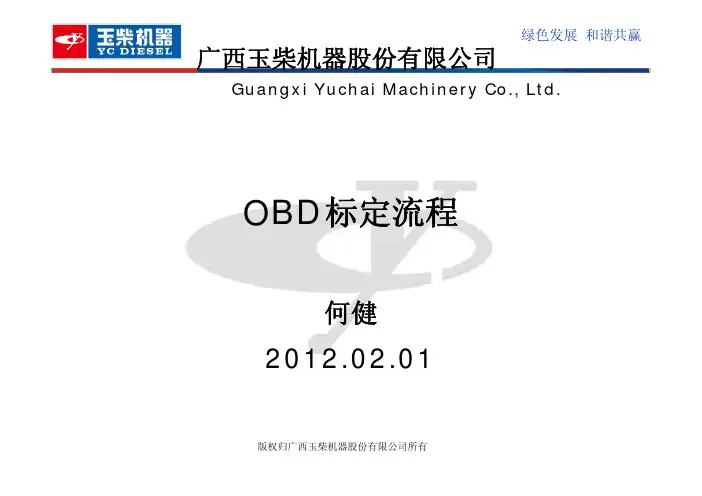

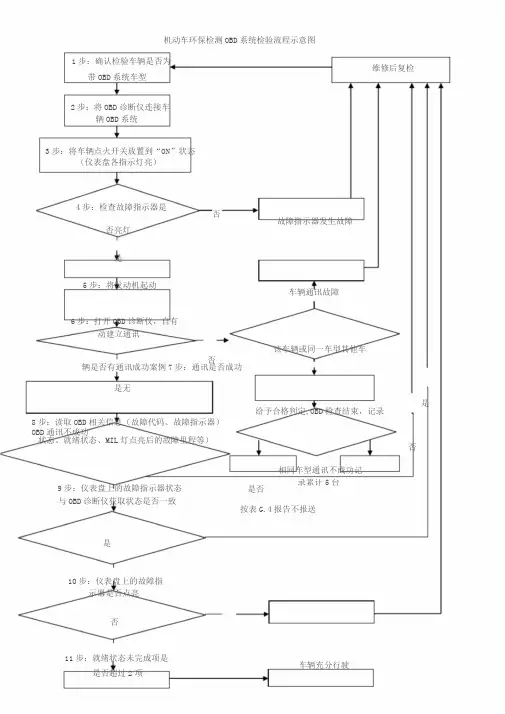
机动车环保检测OBD系统检验流程示意图
1步:确认检验车辆是否为
维修后复检带OBD系统车型
2步:将OBD诊断仪连接车
辆OBD系统
3步:将车辆点火开关放置到“ON”状态
(仪表盘各指示灯亮)
4步:检查故障指示器是
否
故障指示器发生故障
否亮灯
是
5步:将发动机起动
车辆通讯故障
6步:打开OBD诊断仪,自有
动建立通讯
该车辆或同一车型其他车
否
辆是否有通讯成功案例7步:通讯是否成功
是无
是
给予合格判定,OBD检查结束,记录
8步:读取OBD相关信息(故障代码、故障指示器)
OBD通讯不成功
状态、就绪状态、MIL灯点亮后的故障里程等)
否
相同车型通讯不成功记
9步:仪表盘上的故障指示器状态
录累计5台是否
与OBD诊断仪获取状态是否一致
按表G.4报告不报送
是
10步:仪表盘上的故障指
示器是否点亮
否
11步:就绪状态未完成项是
车辆充分行驶是否超过2项
专业资料整理
否
OBD检查合格OBD检查结束
专业资料整理。
机动车尾气检测仪器设备日常标定流程下载温馨提示:该文档是我店铺精心编制而成,希望大家下载以后,能够帮助大家解决实际的问题。
文档下载后可定制随意修改,请根据实际需要进行相应的调整和使用,谢谢!并且,本店铺为大家提供各种各样类型的实用资料,如教育随笔、日记赏析、句子摘抄、古诗大全、经典美文、话题作文、工作总结、词语解析、文案摘录、其他资料等等,如想了解不同资料格式和写法,敬请关注!Download tips: This document is carefully compiled by theeditor.I hope that after you download them,they can help yousolve practical problems. The document can be customized andmodified after downloading,please adjust and use it according toactual needs, thank you!In addition, our shop provides you with various types ofpractical materials,such as educational essays, diaryappreciation,sentence excerpts,ancient poems,classic articles,topic composition,work summary,word parsing,copy excerpts,other materials and so on,want to know different data formats andwriting methods,please pay attention!机动车尾气检测仪器设备的日常标定流程详解在现代城市中,机动车尾气排放已成为空气污染的重要源头。
车载诊断系统(OBD)检测规程一、OBD检测程序1.保证被检测车辆处于制造厂规定的正常状态。
2.引车员驾驶被检车辆驶入指定检测区域并熄火等待检测。
3.OBD检测员将车辆‘点火开关’置‘ON档’,并检查车辆仪表盘‘故障指示器’状态;启动车辆发动机,并检查发动机故障灯是否熄灭。
4.将OBD诊断仪插头,接入车辆OBD接口(必要时可使用OBD延长线接入),待OBD诊断仪指示灯点亮为红色后打开PDA诊断程序选择当前插入的OBD诊断仪,并通过PDA端蓝牙建立连接,成功后OBD诊断仪指示灯变为绿色。
5.使用PDA诊断仪启动OBD诊断系统,使用检查功能,检查是否存在排放相关故障代码。
整个过程无需进一步进行人工操作,OBD诊断仪将自动读出检测结果,并将检测结果传输到计算机数据管理系统上,根据输出的检查结果,判断车辆是否存在排放相关故障二、OBD检测结果判定标准1.目测检查被检车辆OBD接口是否正常,是否能正常接入OBD 诊断仪。
2.将OBD诊断仪与车辆诊断接口正确连接后,如果连续两次尝试通讯失败,检测人员应确认该OBD诊断仪与其他车辆的OBD系统是否能够正常进行通讯,如与其他车辆能够正常通讯,则判定该车OBD检查不合格。
3.查看仪表板上故障指示器显示的状态与从OBD诊断仪获取的状态信息是否一致。
如果二者的状态一致,并且故障指示器被熄灭,则该项检查合格;若二者状态一致,但是故障指示器被点亮,则该车辆存在与排放相关的故障,车辆排放检验不合格,需要进行维修后复检;若二者状态不一致,判定车辆0BD不合格,需要维修后进行复检。
三、应用标准GB 18285-2018《汽油车污染物排放限值及测量方法(双怠速法及建议工况法)》GB 3847-2018 《柴油车污染物排放限值及测量方法(自由加速法及加载减速法)》。